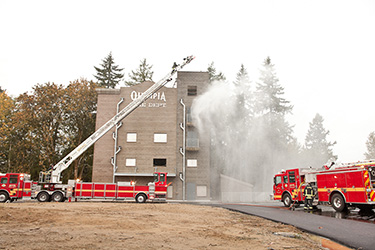|
Subscribe / Renew |
|
|
Contact Us |
|
| ► Subscribe to our Free Weekly Newsletter | |
| home | Welcome, sign in or click here to subscribe. | login |
Construction
| |
 |
November 5, 2015
Fire Training centers today are more like the real world
Rice Fergus Miller

Fergus
|
The changes in the fire service industry over the last 50 years have been unmistakable. They include better protective equipment, the entry of more women, larger and more sophisticated apparatus, recognition of presumptive cancers in firefighters, and the advent of fire-based emergency medical services. The list goes on.
The fires we fight are different as well. With furniture and everyday household products containing more plastics and petroleum-based materials, fires are burning hotter and faster, and the dangers of flashover occur substantially earlier.
Training has changed, too, in large part as a result of these changes in the industry. More importantly, we have become much better teachers.
We have learned how we can provide more effective training and how the training environment itself can better support how the training is delivered. Here are a few notable trends:
Focusing on objectives
The approach to planning and designing fire training facilities today begins with a detailed look at training objectives. This requires gaining an understanding of the specific skills that need to be taught. These skills are derived from the broader context of the particular community.
A community risk assessment identifies the potential natural and man-made disasters that emergency responders in that particular region could face. A review of the agency’s response data further reveals the most common types of responses their personnel are called upon. Tailoring the training environment specifically to that community, the risks existing there, and preparing those firefighters for those situations ensures they are as prepared as they can be.
Realistic scenarios
Today’s training centers focus more heavily on creating greater realism for the trainee. It is not often that a fire department responds to a concrete building on fire in the middle of a parking lot. Although that has been the standard design practice for decades, it doesn’t match the risks and dangers emergency responders face in the real world today.
Giving thought to intervening roads, cul-de-sacs, spaces between buildings, and obstacles like parked cars enhances the training experience. Locating fire hydrants where they are likely found in the real world, as opposed to where it’s convenient, adds dimension and challenge to the drill.
Using a variable pump on the hydrant system can simulate a loss of pressure, again mimicking what could occur on an actual call.
Roadways
Roads within a training campus are being viewed as more than just a means to get to a particular prop — they can be integral to driver training. Roads designed with pavement markings and actual traffic signs can further enhance the realism of the training experience.
Water bodies
Whether a natural lake, wetland or storm pond, opportunities abound for learning proper techniques for drafting water and a variety of water rescue scenarios. Placing vehicles so they are partially or fully submerged adds other training opportunities. A natural ravine is good for swift-water rescue training, which involves using ropes and technical rescue equipment.
Topography
Topography has many benefits in a training campus environment. Many fire districts have found the advantages of creating multistory training structures with on-grade access to different floors on different sides of the building.
In a simulated residential structure, it’s a daylight basement. In a simulated commercial structure, it tests communication between responders entering from opposite sides of the building.
Topography is also beneficial for driver training, as well as extrication from a car over an embankment.
Working with neighbors
Regardless of whether the adjoining property is farmland or a residential development, neighbors care about what gets built next to them. They will have concerns about lights and noise, night operations and smoke drifting in their direction.
Fire departments that proactively address these potential impacts with nearby property owners at the onset (and mitigating them to the best of their ability) ensure a more positive relationship with them for years to come.
When thinking about replacing or adding to your current training facilities, value can be found in a thoughtful process that confirms your most pressing training objectives, how they are taught, and the environment that fosters that education. Without question, the results can be invaluable.
Rice Fergus Miller Principal Dave Fergus is an expert at programming, planning, and designing fire and emergency services facilities. He has completed more than 200 civic projects over the last 25 years and regularly consults with public agencies on project feasibility, service locations, capital project funding and other strategic issues.
Other Stories:
- Will your fire station be open after the Big One hits?
- Here’s how we slashed one station’s energy use by 75 percent
- Interbay fire station is one of the nation’s greenest
- How to keep fire crews moving as the city grows



